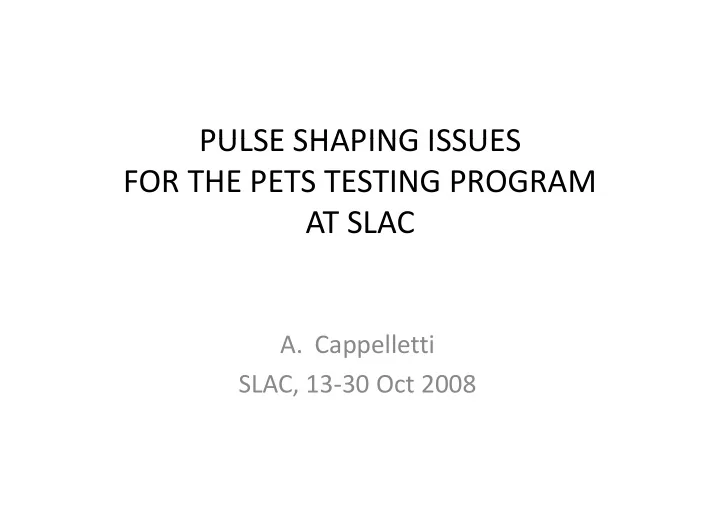

PULSE SHAPING ISSUES PULSE SHAPING ISSUES FOR THE PETS TESTING PROGRAM AT SLAC A. Cappelletti SLAC, 13-30 Oct 2008
SYSTEM OVERVIEW LAPTOP LAPTOP AMPLITUDE – PHASE AMPLITUDE – PHASE PULSE S AFG STRUCTURE (LABVIEW CODE) DETECTION SYSTEM COMPRESSION FEEDBACK FEEDBACK H Y B Delay (2 round trips) I + ATTENUATOR Mode conversion H CW @ 11.424 GHz - Y 50 MW @ 1.5 µ s B Other experiment… experiment π/2 ATTENUATOR PH. SHIFTER Q MODULATION POWER SUPPLY
MODULATION • Amplitude and phase data seem to fit, so we should use polar data instead of cartesian I-Q data, but practical concerns make data instead of cartesian I Q data, but practical concerns make I-Q data a better choice. • Manipulating amplitude and phase of a carrier sine would be expensive difficult and not as flexible as a circuit that uses I Q expensive, difficult and not as flexible as a circuit that uses I-Q waveforms. We control amplitude and phase of an RF carrier by operating the amplitudes of separate I and Q inputs.
POWER SUPPLY • ASTA (Accelerating Structure Test Area) hosts two 50 MW Klystrons supplying up to 500 MW @ 64 ns (and almost 300 Klystrons, supplying up to 500 MW @ 64 ns (and almost 300 MW @ 260 ns); 90 MW if delay lines are not used. • A relative phase shift of either 0 or 180 degrees allows to p g direct the power towards a specific hybrid output.
PULSE COMPRESSION SLED II uses low-loss resonant lines (yielding flat-topped output pulses), 26 ft long, • and mode transducers. 1 RTT (Round Trip Time) = 132 ns; we use 2 RTT. One compressed-pulse-time from the end, the phase of the input is reversed, so O d l i f h d h h f h i i d • that the field reflected from the coupling interface adds constructively to the field emitted from the charged cavity; then the stored energy is extracted. We worked with 8 sub-intervals, 132 ns each. •
FEEDBACK SYSTEM 1.174 GHz 10.25 GHz Amp. MIXER 10 MHz signal A Detection Low noise block downconverter ( LNB ) FM φ 11.424 GHz Amp. - Phase signal Detection A (slow…)
FEEDBACK CORRECTION Non-idealities in the klystrons outputs, as well as in the pulse compressor, make • the pulses not constant both in amplitude and in phase. As a result, the system produces pulses affected by ripple: this is deemed to be A l h d l ff d b i l hi i d d b • responsible of a 30 % loss in terms of efficiency (presently, efficiency level is 60%) Objective: developing an algorithm for point by point correction of the waveform Objective: developing an algorithm for point-by-point correction of the waveform • • which the system is initially fed.
System setup ( h (…hardware/system d / interfacing… ) “Early” LabVIEW interface for coarse shaping… f p g
• … but an automatic correction code is required to be developed, in the framework of a longer-term cooperation with SLAC g p � Training program; o SO (safety) ( y) o EOSH (environmental safety and health) o GERT (radiological training) GERT (radiological training) o Electrical Safety o RWT 1 (work in radiation areas) o ASTA Operator p o …
Recommend
More recommend